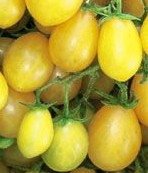Ly co PER si con Greek lykos meaning wolf, and persicon meaning peach
 Lycopersicon is the part of the scientific name for tomato and literally means wolf-peach. Tomatoes are a member of the deadly nightshade family (Solonaceae) and were thought to be poisonous because botanists mistakenly associated them with the wolfpeach mentioned by Galen of Pergamon, a Greek physician writing in the third century AD. In fact, only tomato leaves are poisonous,not the fruit. Yes, botanically tomatoes are a type of fruit (a berry) but in legal practice they are considered a vegetable.
Lycopersicon is the part of the scientific name for tomato and literally means wolf-peach. Tomatoes are a member of the deadly nightshade family (Solonaceae) and were thought to be poisonous because botanists mistakenly associated them with the wolfpeach mentioned by Galen of Pergamon, a Greek physician writing in the third century AD. In fact, only tomato leaves are poisonous,not the fruit. Yes, botanically tomatoes are a type of fruit (a berry) but in legal practice they are considered a vegetable.
Tomatoes are native to western South America and Central America dating back to at least 500 BC. The native tomatoes were probably small and yellow as the Italians and Spanish call them pomi d’oro, meaning yellow apples. Cortez brought seeds from Montezuma’s garden to Europe in 1519 where they were grown as curiosities but not eaten by many Europeans because the bright shiny color was thought to be an indication of the tomato’s poisonous nature. The Italians were the first European to cultivate tomatoes but the American soup maker Campbell may be credited with making the tomato the popular food that it is today.
Although the French call tomatoes pommes d’amour, or love apples, because of their supposed aphrodisiac properties, their lycopene content is probably more important . lycopene is powerful natural antioxidant that can help protect the skin against UV rays and sunburn, and keep the skin young looking. Some experts think lycopene is helpful in the fight against cancer but the evidence is not conclusive.